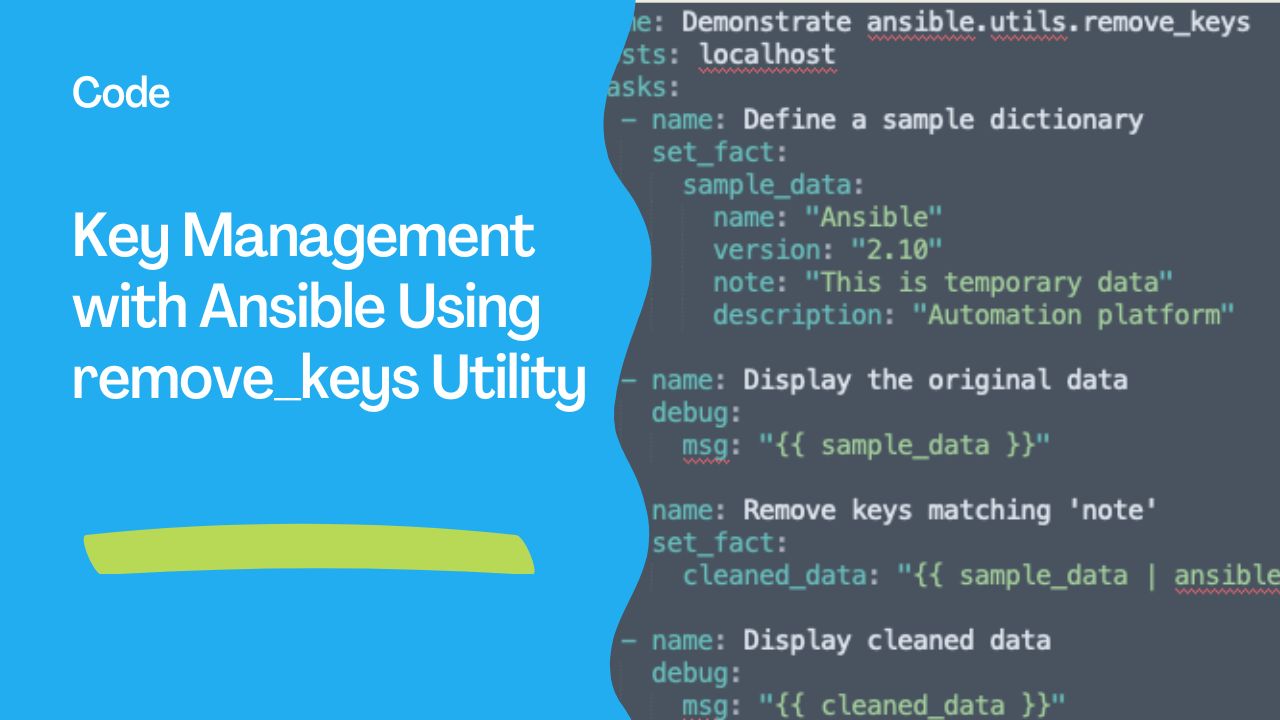Introduction
In automation workflows, efficient data manipulation plays a crucial role, especially when managing sensitive data or cleaning structured inputs. Ansible, known for its simplicity and flexibility, offers utilities to handle such scenarios. One such utility is ansible.utils.remove_keys, a Python method used to remove keys from a dictionary based on specified criteria, such as matching patterns.
This article dives into the utility’s usage, focusing on the target and matching_parameter arguments, and demonstrates its practical application with an Ansible playbook.
Understanding ansible.utils.remove_keys
The ansible.utils.remove_keys method provides a systematic way to delete dictionary keys. Key arguments include:
target: A regular expression (regex) pattern defining which keys to target for removal.matching_parameter: Defines how the matching is determined. For regex-based matching, this value is"regex".
For example:
ansible.utils.remove_keys(target='^note$', matching_parameter='regex')
This removes keys named "note" from the given dictionary.
Why Use ansible.utils.remove_keys?
- Data Cleaning: Useful when cleaning unwanted metadata or temporary data.
- Enhanced Security: Prevents accidental propagation of sensitive information.
- Flexibility: Allows dynamic targeting of keys using regex patterns.
Playbook Demonstration
Below is a simple playbook leveraging the ansible.utils.remove_keys utility:
---
- name: Demonstrate ansible.utils.remove_keys
hosts: localhost
tasks:
- name: Define a sample dictionary
set_fact:
sample_data:
name: "Ansible"
version: "2.10"
note: "This is temporary data"
description: "Automation platform"
- name: Display the original data
debug:
msg: "{{ sample_data }}"
- name: Remove keys matching 'note'
set_fact:
cleaned_data: "{{ sample_data | ansible.utils.remove_keys(target='^note$', matching_parameter='regex') }}"
- name: Display cleaned data
debug:
msg: "{{ cleaned_data }}"
Explanation of the Playbook
- Setup Sample Data: Creates a dictionary with some keys to simulate structured input.
- Show Original Data: Uses the
debugmodule to display the dictionary before processing. - Remove Unwanted Keys: Applies the
ansible.utils.remove_keysutility to remove keys matching the regex pattern (notein this case). - Output Cleaned Data: Displays the dictionary after key removal.
Running the Playbook
- Save the playbook as
remove_keys_demo.yml. - Execute it with:
ansible-playbook remove_keys_demo.yml - Observe the output to confirm that the
"note"key has been successfully removed.
Example Output
TASK [Display the original data] *********************************************
ok: [localhost] => {
"msg": {
"description": "Automation platform",
"name": "Ansible",
"note": "This is temporary data",
"version": "2.10"
}
}
TASK [Display cleaned data] *************************************************
ok: [localhost] => {
"msg": {
"description": "Automation platform",
"name": "Ansible",
"version": "2.10"
}
}
Conclusion
The ansible.utils.remove_keys utility simplifies dictionary manipulation within Ansible workflows, offering a powerful tool for dynamic key removal. Its flexibility to use regex ensures precise targeting, making it invaluable for cleaning data structures in real-world scenarios.
Integrating such utilities into your playbooks not only reduces manual overhead but also enforces consistency across automation tasks. Experiment with this playbook to see how this utility can streamline your data handling processes!
Subscribe to the YouTube channel, Medium, and Website, X (formerly Twitter) to not miss the next episode of the Ansible Pilot.Academy
Learn the Ansible automation technology with some real-life examples in my
Udemy 300+ Lessons Video Course.

My book Ansible By Examples: 200+ Automation Examples For Linux and Windows System Administrator and DevOps

Donate
Want to keep this project going? Please donate
